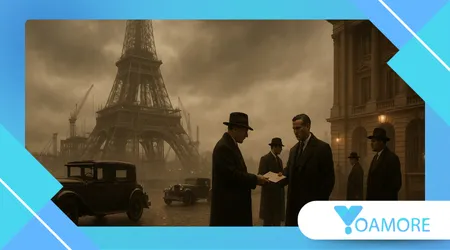Cuando la Torre Eiffel estuvo a punto de ser vendida como chatarra.

Eiffel Tower scam 1925 remains one of the most astonishing episodes in European criminal history. The story blends political vulnerability, economic tension, psychological manipulation, and extraordinary boldness, turning a seemingly impossible event into a real historical case.
Anuncios
Why does this story still capture so much attention?
The attempted sale of the Eiffel Tower for scrap fascinates modern readers because it shows how even powerful institutions can be manipulated when confidence drops and communication fails.
Paris in the 1920s faced political disagreement, rapid technological change, and unstable economic conditions. Those elements created the perfect environment for a skilled con artist to thrive.
Viktor Lustig saw uncertainty as an opening. Com documentos falsos e um papel convincente de funcionário discreto, ele fez empresários acreditarem que a França planejava desmontar a torre devido aos altos custos. A combinação de urgência, sigilo e aparente exclusividade tornou a proposta difícil de recusar.
This event matters today because it highlights how social engineering, flawed verification systems, and emotional vulnerability can influence decision-making, especially within competitive economic sectors.
Anuncios
++The Lost Colony of Roanoke: America’s First Unsolved Mystery
What exactly was the scam that nearly dismantled the Eiffel Tower?
In 1925, Viktor Lustig impersonated a high-ranking French government representative responsible for managing public monuments.
He invited scrap-metal businessmen to a private meeting at the Hôtel de Crillon, presenting forged documents describing the tower’s “imminent decommissioning.” According to his narrative, the structure had become too expensive to maintain, and the government preferred to sell the metal quietly to avoid public outrage.
Among the businessmen present, André Poisson became the perfect target. New to the Parisian market and eager to gain influence, Poisson believed he had been granted access to privileged information.
Lustig nurtured that illusion, reinforcing the idea of an exclusive opportunity that demanded immediate action.
Poisson paid a large “approval fee,” unaware that the papers and permissions were entirely fabricated. Lustig vanished from France shortly afterward.
How did Viktor Lustig manage to execute the plan so effectively?
Lustig’s success came from meticulous preparation. He studied government communication styles, learned bureaucratic terminology, and analyzed public debates around expensive monument maintenance. Because the Eiffel Tower had been controversial since its construction, his narrative sounded plausible.
He selected the Hôtel de Crillon—a venue associated with government negotiations—to give credibility to the meeting. He also emphasized discretion, claiming the government feared public protests if the plan leaked. That argument aligned perfectly with existing political tensions in 1920s France.
Most importantly, Lustig understood human psychology. He sensed Poisson’s insecurity in the Parisian business scene and exploited his ambition. By appealing to exclusivity and urgency, he convinced Poisson to act before verifying the documents.
++La gran inundación de melaza: cuando Boston se ahogó en jarabe
When did the scandal gain international attention?
Poisson discovered the fraud only after attempting to confirm logistical details with actual government offices. Realizing he had been deceived, he experienced both embarrassment and fear. Public exposure could damage his reputation, so he hesitated before reporting the case.
However, French authorities eventually became aware of the scam, and journalists began documenting the event. International newspapers found the story irresistible: Europe’s most iconic structure nearly sold by a master con artist. The tale spread quickly, turning Lustig into a legendary figure in criminal history.
He fled to Austria and later continued operating in the United States, where he became known for sophisticated scams, including forging U.S. currency. His “Eiffel Tower scheme” remained one of the most creative examples of social engineering of the century.
Why was the Eiffel Tower vulnerable during that period?

After World War I, France was deeply affected by economic instability, reconstruction costs, and political disputes. The Eiffel Tower—originally intended as a temporary structure—had faced criticism for decades. Maintenance costs were high, and debates over its purpose resurfaced regularly.
These factors made Lustig’s narrative believable. Industrialists knew that public money was limited, and rumors about monument decommissioning were not uncommon. On top of that, document authentication procedures were far less advanced than they are today. Forged seals and signatures often went undetected.
Businesses operated under intense competition, and opportunities involving metal, shipping, and infrastructure promised large profits. Many entrepreneurs rushed into deals without the due diligence that would be standard today. (“Un Jour de Plus à Paris”)
Which economic indicators help explain France’s instability in 1925?
Post-war Europe faced inflation, debt, and fluctuating industrial output. France’s reconstruction efforts increased public expenses, while international markets influenced the price of essential materials.
Here is a historically accurate snapshot (sources: Banque de France, OECD economic studies):
France’s Economic Indicators (1923–1926)
| Año | Approx. Inflation | Industrial Growth | Public Debt (% of GDP) |
|---|---|---|---|
| 1923 | 13% | 4.1% | 170% |
| 1924 | 18% | 3.2% | 182% |
| 1925 | 26% | 2.4% | 188% |
| 1926 | 19% | 3.8% | 174% |
This economic environment explains why businessmen were eager to secure profitable contracts quickly, often skipping verification processes that would have exposed the scam.
How did the scam influence modern investigation and verification methods?
After the scandal, French authorities strengthened documentation protocols, created stricter validation procedures, and encouraged businesses to consult independent legal advisors before signing agreements involving government resources.
The case also inspired new approaches in criminal psychology. Investigators studied Lustig’s techniques to improve fraud detection and understand how persuasive communication affects decision-making. His methodology helped shape future training in financial crime investigation.
Today, several aspects of modern document authentication—such as standardized signatures, secure printing, and institutional cross-verification—are partly rooted in lessons learned from similar historical frauds.
++The Real Dracula and His Bloody Reign in Wallachia
Why does the story still matter in 2025?
The episode remains relevant because fraud evolves, but human vulnerability does not. Scarcity, urgency, social pressure, and desire for opportunity continue to influence executives and investors. Lustig’s strategy demonstrates how manipulation relies far more on emotional intelligence than on technical skill.
Understanding this case strengthens organizational resilience. It highlights the importance of independent verification, transparent communication, and critical analysis before closing major deals. Modern cybersecurity and anti-fraud methods still rely on the same principles.
Most of all, the attempted sale of the Eiffel Tower shows that even the most iconic symbols can become targets when institutions, markets, and individuals face uncertainty. (“Lessons on modern financial scams from the man who sold the Eiffel Tower”)
Preguntas frecuentes
Why is the 1925 scam so famous?
Because it involved one of the world’s most recognizable monuments and a con artist who exploited political instability and emotional vulnerability with exceptional precision.
Who was Viktor Lustig?
An internationally known con artist, fluent in multiple languages, and considered one of the most skilled social engineers of the early 20th century.
Was the Eiffel Tower really at risk?
No. The French government never considered dismantling it. The scam relied on existing maintenance debates and forged documents.
Why did the victim hesitate to report the crime?
Poisson feared reputational damage. In business environments driven by competition and prestige, admitting such a loss was extremely difficult.
What lessons does the case teach today?
Always verify documents, consult independent experts, recognize emotional manipulation, and avoid high-pressure deals that rely on secrecy or urgency.
